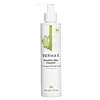What's inside
What's inside
 Key Ingredients
Key Ingredients

 Benefits
Benefits

 Concerns
Concerns

No concerns
 Ingredients Side-by-side
Ingredients Side-by-side

Water
Skin ConditioningGlycerin
HumectantPropanediol
SolventStearyl Alcohol
EmollientDecyl Glucoside
CleansingPanthenol
Skin ConditioningPinus Pinaster Bark Extract
AntioxidantAllantoin
Skin ConditioningCamellia Sinensis Leaf Extract 0.1%
AntimicrobialAloe Barbadensis Leaf Extract 0.1%
EmollientChamomilla Recutita Flower Extract 0.1%
MaskingCymbopogon Schoenanthus Extract 0.1%
Skin ConditioningXanthan Gum
EmulsifyingGlyceryl Stearate Citrate
EmollientPotassium Sorbate
PreservativePhenoxyethanol
PreservativeEthylhexylglycerin
Skin ConditioningWater, Glycerin, Propanediol, Stearyl Alcohol, Decyl Glucoside, Panthenol, Pinus Pinaster Bark Extract, Allantoin, Camellia Sinensis Leaf Extract 0.1%, Aloe Barbadensis Leaf Extract 0.1%, Chamomilla Recutita Flower Extract 0.1%, Cymbopogon Schoenanthus Extract 0.1%, Xanthan Gum, Glyceryl Stearate Citrate, Potassium Sorbate, Phenoxyethanol, Ethylhexylglycerin
Water
Skin ConditioningHelianthus Annuus Seed Oil
EmollientGlycerin
HumectantCetyl Alcohol
EmollientBeeswax
Emulsion StabilisingSucrose Stearate
EmollientCetearyl Alcohol
EmollientCocos Nucifera Oil
MaskingGossypium Herbaceum Flower Extract
HumectantOryza Sativa Extract
AbsorbentBeta Vulgaris Root Extract
Skin ConditioningQuillaja Saponaria Bark Extract
CleansingTheobroma Cacao Seed Butter
EmollientYucca Schidigera Leaf/Root/Stem Extract
CleansingArtemisia Umbelliformis Extract
Skin ConditioningEuphrasia Officinalis Extract
AntimicrobialHamamelis Virginiana Water
AstringentSaccharum Officinarum Extract
MoisturisingAloe Barbadensis Leaf Juice
Skin ConditioningSilica
AbrasiveSucrose
HumectantFructose
HumectantGlucose
HumectantCoco-Glucoside
CleansingMaltodextrin
AbsorbentCitric Acid
BufferingBenzoic Acid
MaskingTrehalose
HumectantXanthan Gum
EmulsifyingPotassium Sorbate
PreservativeSodium Benzoate
MaskingCI 77947
Alcohol Denat.
AntimicrobialPhenoxyethanol
PreservativeWater, Helianthus Annuus Seed Oil, Glycerin, Cetyl Alcohol, Beeswax, Sucrose Stearate, Cetearyl Alcohol, Cocos Nucifera Oil, Gossypium Herbaceum Flower Extract, Oryza Sativa Extract, Beta Vulgaris Root Extract, Quillaja Saponaria Bark Extract, Theobroma Cacao Seed Butter, Yucca Schidigera Leaf/Root/Stem Extract, Artemisia Umbelliformis Extract, Euphrasia Officinalis Extract, Hamamelis Virginiana Water, Saccharum Officinarum Extract, Aloe Barbadensis Leaf Juice, Silica, Sucrose, Fructose, Glucose, Coco-Glucoside, Maltodextrin, Citric Acid, Benzoic Acid, Trehalose, Xanthan Gum, Potassium Sorbate, Sodium Benzoate, CI 77947, Alcohol Denat., Phenoxyethanol
 Reviews
Reviews

Alternatives
Ingredients Explained
These ingredients are found in both products.
Ingredients higher up in an ingredient list are typically present in a larger amount.
Glycerin is already naturally found in your skin. It helps moisturize and protect your skin.
A study from 2016 found glycerin to be more effective as a humectant than AHAs and hyaluronic acid.
As a humectant, it helps the skin stay hydrated by pulling moisture to your skin. The low molecular weight of glycerin allows it to pull moisture into the deeper layers of your skin.
Hydrated skin improves your skin barrier; Your skin barrier helps protect against irritants and bacteria.
Glycerin has also been found to have antimicrobial and antiviral properties. Due to these properties, glycerin is often used in wound and burn treatments.
In cosmetics, glycerin is usually derived from plants such as soybean or palm. However, it can also be sourced from animals, such as tallow or animal fat.
This ingredient is organic, colorless, odorless, and non-toxic.
Glycerin is the name for this ingredient in American English. British English uses Glycerol/Glycerine.
Learn more about GlycerinPhenoxyethanol is a preservative that has germicide, antimicrobial, and aromatic properties. Studies show that phenoxyethanol can prevent microbial growth. By itself, it has a scent that is similar to that of a rose.
It's often used in formulations along with Caprylyl Glycol to preserve the shelf life of products.
Potassium Sorbate is a preservative used to prevent yeast and mold in products. It is commonly found in both cosmetic and food products.
This ingredient comes from potassium salt derived from sorbic acid. Sorbic acid is a natural antibiotic and effective against fungus.
Both potassium sorbate and sorbic acid can be found in baked goods, cheeses, dried meats, dried fruit, ice cream, pickles, wine, yogurt, and more.
You'll often find this ingredient used with other preservatives.
Learn more about Potassium SorbateWater. It's the most common cosmetic ingredient of all. You'll usually see it at the top of ingredient lists, meaning that it makes up the largest part of the product.
So why is it so popular? Water most often acts as a solvent - this means that it helps dissolve other ingredients into the formulation.
You'll also recognize water as that liquid we all need to stay alive. If you see this, drink a glass of water. Stay hydrated!
Learn more about WaterXanthan gum is used as a stabilizer and thickener within cosmetic products. It helps give products a sticky, thick feeling - preventing them from being too runny.
On the technical side of things, xanthan gum is a polysaccharide - a combination consisting of multiple sugar molecules bonded together.
Xanthan gum is a pretty common and great ingredient. It is a natural, non-toxic, non-irritating ingredient that is also commonly used in food products.
Learn more about Xanthan Gum